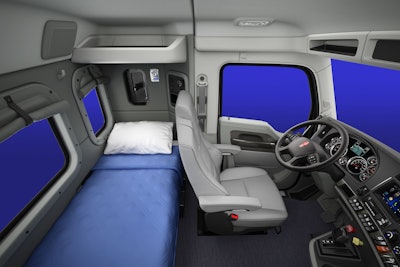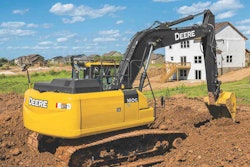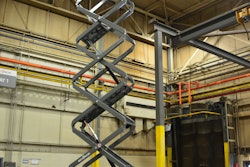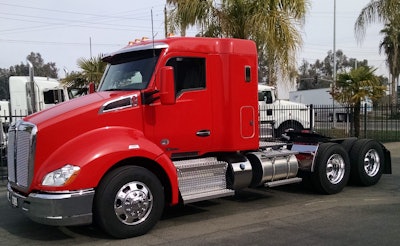 T680 with 40-inch sleeper
T680 with 40-inch sleeperKenworth announced several new options for its T880 and T680 Sunday at the Technology & Maintenance Council (TMC) meeting in Nashville, Tenn.
A 40-inch sleeper for the T880 and T680 will enter production March 7.
Jason Skoog, Kenworth assistant general manager for sales and marketing, says the 40-inch sleeper offers drivers organizational features to make the space as efficient as possible for those who occasionally stay overnight.
“The layout provides excellent flexibility and choice in meeting the operational needs of truck fleets and operators,” he says. “In addition, it’s 260 pounds lighter than the Kenworth 52-inch regional sleeper offering important weight savings for additional payload.”
Compared to the Kenworth 38-inch AeroCab sleeper, the 40-inch sleeper’s 22 cubic feet of storage space is greater, and its roof is 6 inches lower at 87 inches, making the 40-inch sleeper the ideal height for vocational customer requirements.

An optional 19-inch by 36-inch stationary or sliding window on the back of the sleeper is available as are two additional 19-inch by 12-inch outboard windows to go with the larger window. Additional options include LED marker lights, extreme temperature insulation, premium speakers, side extenders, and stainless steel sun visor.
Additionally, Kenworth is making its Aero Advantage Fairing available for order with the T680 Advantage and the 76-inch high- and mid-roof sleepers.
Skoog says the new Kenworth Aero Advantage Fairing flares out to better direct airflow around the rear wheels and allows for better packaging, and the new design provides for an optional under-sleeper fuel fill, which enables fuel tanks to be moved forward while reducing trailer gap and wheelbase to further enhance aerodynamics. With that added room, customers who want to install their own APUs can do so behind the optimized aero fairing.
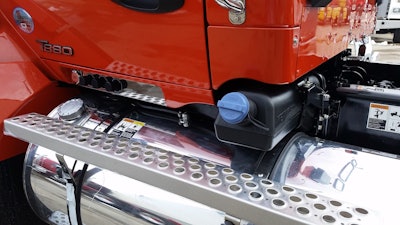
Optional back of cab clear DEF tank, Bendix Wingman Fusion platform
An optional clear back-of-cab, DEF tank configuration for the T880 and T680 will be available in April.
Skoog says the tank is designed to maximize fuel capacity by removing the DEF tank from the frame rail and mounting it above the fuel tank and under the cab.
When combined with an in-cab battery box, right-hand under-cab aftertreatment and left-hand under-cab fuel tank, this new option can provide clear back of cab to assist in body installations, Skoog adds.
“Customers can more easily accommodate service bodies without requiring a lot of customization, and body installers can also more easily relocate all the tanks and pumps to meet their own requirements because the DEF tank will be tucked out of the way above the fuel tank,” he says.
The configuration features a new lightweight 7.3-gallon DEF tank, cutting about 25 pounds from the weight of a standard-mounted DEF tank.
Both models are also getting the option to equip with the Bendix Wingman Fusion driver assistance system.
Bendix Wingman Fusion integrates and advances a suite of Bendix safety technologies – radar, camera, the vehicle’s brake system, and SafetyDirect by Bendix CVS – into a comprehensive driver assistance system.
Built on the Bendix, ESP full stability program, Wingman Fusion offers enhanced collision mitigation, lane departure warning, stationary vehicle braking, and overspeed alert and action. This combination typically enables the system to assess a situation faster and react earlier, alerting the driver and decreasing the vehicle’s speed by up to twice as much, while also reducing instances of false alerts and false interventions.
Skoog says Bendix Wingman Fusion can help drivers maintain safe distances, mitigate collisions with other motorists who change lanes suddenly, and safely operate in rapidly changing and difficult-to-see conditions like snow, rain, fog, dust or smoke.”
When the system’s radar, Bendix Wingman Advanced, detects a large stationary object in the truck’s lane of travel, the Wingman Fusion compares the data from the radar with images from its forward-looking cameras to determine in a split second whether the object in the road is a vehicle. If the system determines the object is a stationary vehicle, it alerts the driver with an audio sound and visual graphics on the Bendix driver interface unit.
If the driver fails to take action to address the situation, the system can then engage the brakes to assist the driver in helping to avoid a collision or lessen the severity. If the system cannot determine whether the object is a stationary vehicle, it provides the driver audible and visual alerts, but does not engage the brakes.
The system also uses its camera – powered by the Mobileye System-on-Chip EyeQ processor with state-of-the-art vision algorithms – to read posted speed limit signs and to constantly monitor the truck’s speed. If the driver operates more than 5 mph above the posted speed limit, the system can be set to provide the driver an audible alert. If the driver goes 10 mph over the speed limit, the system provides an audible alert and then a 1-second dethrottle of the engine to get the driver’s attention.
The fleet can also integrate the driver assistance system with Bendix SafetyDirect, a web-based program that offers fleet operators videos of severe events, along with comprehensive fleet and driver feedback. The optional program also allows fleets to observe real-time driver performance data and event-based information for analysis and training.
“By employing Bendix Wingman Fusion, along with SafetyDirect, fleets can use alerts and interventions, plus insights from the system to help drivers make safer choices,” Skoog said.
Bendix Wingman Fusion features alert prioritization. If multiple system alerts are triggered simultaneously, such as a lane departure warning and impact alert, Wingman Fusion arranges the alerts in order of importance and first delivers the more crucial one to the driver to minimize driver distraction.
“The system’s combination of technologies provides our customers with a collision avoidance system to help reduce the chances of drivers experiencing false alerts or activations,” Skoog said. “The Wingman Fusion also provides fleets opportunities to better understand what’s happening out there on the road and reduce overspeeding incidents.”
According to Bendix, driver assistance technologies – such as Bendix Wingman Fusion – are designed to complement safe drivers, safe driving practices, and proactive driver training programs, not replace them. Responsibility for the safe operation of the vehicle remains with the driver at all times.
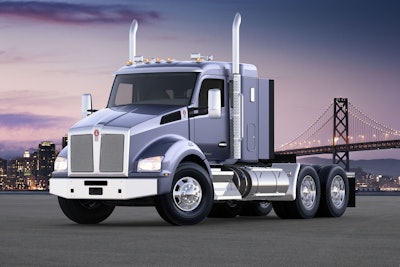
Engine Auto Start and Stop added to T880
Kenworth is adding Engine Auto Start and Stop monitoring system capability to Kenworth T880 equipped with sleepers.
In addition to detecting when batteries get to a critical level, Kenworth’s Auto Start and Stop can now detect when engine oil temperature dips to a point where it could cause fuel gelling.
The option may be ordered with or without the Kenworth Idle Management System, a battery-based APU system. In addition, Kenworth has added the engine monitoring system to include Kenworth T680 and T880 day cabs.
The option may be ordered with or without the Kenworth Idle Management System, a battery-based APU system. In addition, Kenworth has added the engine monitoring system to include Kenworth T680 and T880 day cabs.
“Our system is proactive,” says Skoog. “Instead of shutting down battery draws, or letting the engine oil temperature get to a state of no return, Auto Start and Stop automatically starts the main engine to keep all systems going. Once at a designated level of charge or oil temperature, the engine shuts down.”
Skoog says the truck operator does not need to be with the truck for auto start/stop to be engaged.
“The truck is in auto-pilot, so if the driver is off-site or eating dinner for example, the truck will turn on to recharge the batteries and get engine oil back to a normal operating temperature,” he adds. “There are safeguards in place, so the truck cannot be moved or stolen when the auto start feature is activated.”
For added battery monitoring, the Kenworth Driver Performance Center on the Kenworth T680 and T880 provides the operator with real-time information on the battery state of charge and oil temperature.
“When the engine comes on for recharging, the driver can watch the progression,” Skoog says. “If only an hour or two more power is needed before leaving to deliver a load, the driver can shut down the system early and use the battery power, then recharge the battery banks while on the road.”

